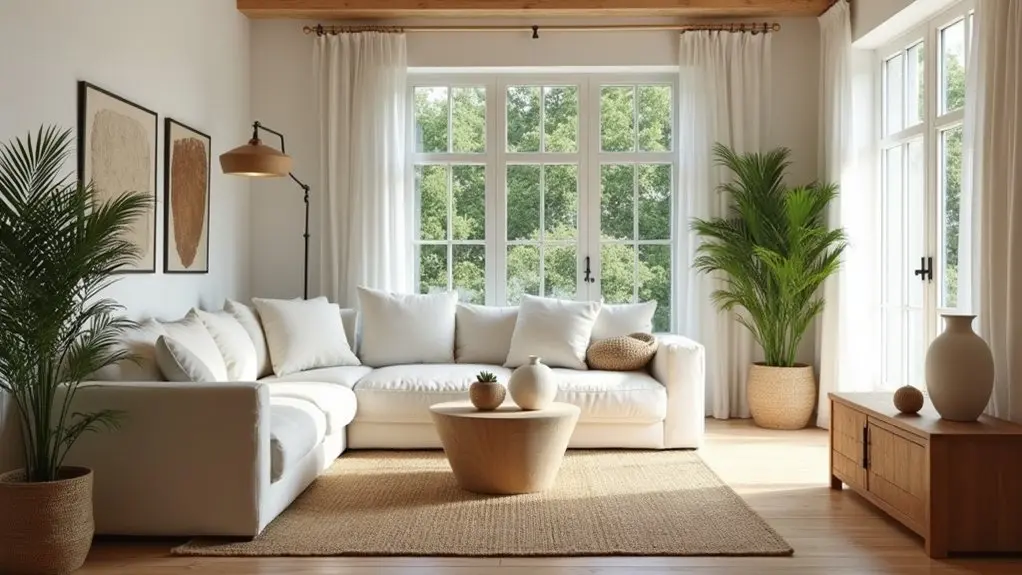
14 White and Natural Wood Living Room Ideas That Feel Earthy and Modern
White and natural wood living rooms blend crisp white walls and light wood accents for a bright, airy look. Layering cozy wool and cotton throws, incorporating woven baskets, and adding rattan create inviting texture. Organic-shaped furniture, a white sofa, and stone or ceramic decor bring modern warmth, while indoor greenery infuses energy. Consider darker wood or paneling for contrast and architectural interest. Explore how these 14 ideas combine earthy elegance with contemporary appeal in greater detail below.
Key Takeaways
- Use crisp white walls with warm natural wood accents for a bright, spacious, and earthy modern foundation.
- Incorporate light wood flooring and sheer curtains to maximize natural light and create an airy, inviting atmosphere.
- Choose a white sofa as a versatile base, layering with cozy throws and natural fiber rugs for added warmth and texture.
- Add organic-shaped furniture, stone accents, and handcrafted ceramics to introduce visual interest and natural sophistication.
- Integrate lush greenery and woven baskets to enhance earthiness, provide fresh energy, and reinforce the organic decor theme.
Pair Crisp White Walls With Warm Wood Accents
When crisp white walls serve as the foundational backdrop of a living room, they amplify natural light, visually expanding the space and establishing a neutral canvas. Integrating warm wood accents—such as oak beams, pine shelving, or walnut furniture—introduces depth, tactile contrast, and organic warmth against the streamlined purity of white walls. This deliberate juxtaposition fosters a contemporary yet inviting environment, balancing minimalist aesthetics with earthy undertones. Employing light wood varieties strengthens Scandinavian influences, emphasizing both simplicity and functional design. To unify the scheme, accessories in earthy tones—clay vases, terracotta planters, or linen cushions—can be strategically placed, enhancing cohesion and visual interest. This approach delivers a harmonious, nature-connected atmosphere that remains adaptable to evolving decor preferences while retaining timeless appeal. Incorporating houseplants to balance the decor can further enhance the aesthetic, creating a more vibrant and inviting space.
Layer Cozy Textures With Throws and Rugs
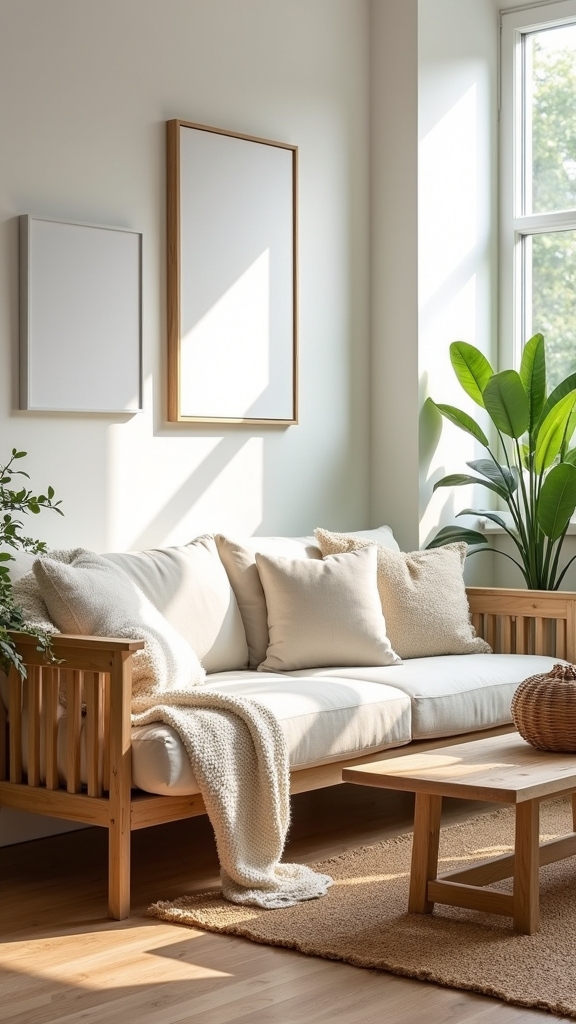
For ideal tactile richness, designers recommend mixing wool and cotton throws, accented with chunky knit layers, to introduce both visual depth and tactile comfort. Layering natural fiber rugs, such as jute or sisal, grounds the space while reinforcing the organic palette. This strategic combination enhances warmth and cohesion within a white and natural wood living room. Incorporating plush throws for warmth and tactile allure can further enhance comfort and maintain stylish design elements, enriching the overall atmosphere.
Mix Wool and Cotton
By thoughtfully layering wool and cotton through throws and rugs, a living room in white and natural wood achieves both tactile richness and visual cohesion. This expert pairing utilizes natural textures to create an inviting, earthy environment that feels modern and serene. Wool’s inherent insulation enhances warmth underfoot, while cotton’s breathability maintains a balanced climate, making these natural materials perfect for year-round comfort. Visually, the juxtaposition of plush wool rugs with soft cotton throws introduces depth and subtle pattern, amplifying the organic aesthetic of wood and white decor. Sustainability remains paramount, as both fibers align with eco-friendly principles. For ideal effect, consider the following applications:
| Wool Rugs | Cotton Throws |
|---|---|
| Insulating warmth | Breathable comfort |
| Deep, tactile pile | Lightweight layer |
| Muted, earthy tones | Crisp, natural hues |
Add Chunky Knit Accents
Building upon the interplay of wool and cotton, introducing chunky knit accents intensifies the tactile narrative in a living room defined by white and natural wood.
These substantial knit throws and decorative pillows, draped over sofas or lounge chairs, infuse the environment with warmth and a lived-in feel, simultaneously providing functional comfort and visual intrigue.
Opting for chunky knit pieces in neutral tones strengthens the cohesive relationship between the room’s crisp whites and organic wood elements, ensuring visual harmony.
When layered thoughtfully, these textures break the monotony of smooth surfaces, anchoring the modern aesthetic with inviting softness.
Chunky knit accents also enhance the seasonal adaptability of the space, offering both insulation during colder months and a textural depth that boosts the overall layered design approach.
Layer Natural Fiber Rugs
A foundation of natural fiber rugs—such as jute or sisal—instantly enhances the tactile and visual depth of a white and natural wood living room.
To achieve an earthy interior design, professionals recommend layering rugs of varying sizes and weaving in different textures. This approach not only defines zones within an open plan but also amplifies coziness and warmth.
Selecting rugs in organic patterns and muted earth tones guarantees a seamless integration with the overall color palette, preserving the room’s serene cohesion.
For added comfort and visual interest, soft throws in complementary shades may be draped atop the rugs, inviting relaxation.
Beyond aesthetics, natural fiber rugs offer durability and eco-friendly credentials, making them a pragmatic solution for sustainable, high-traffic spaces seeking tactile sophistication.
Incorporate Organic Shapes in Furniture Design
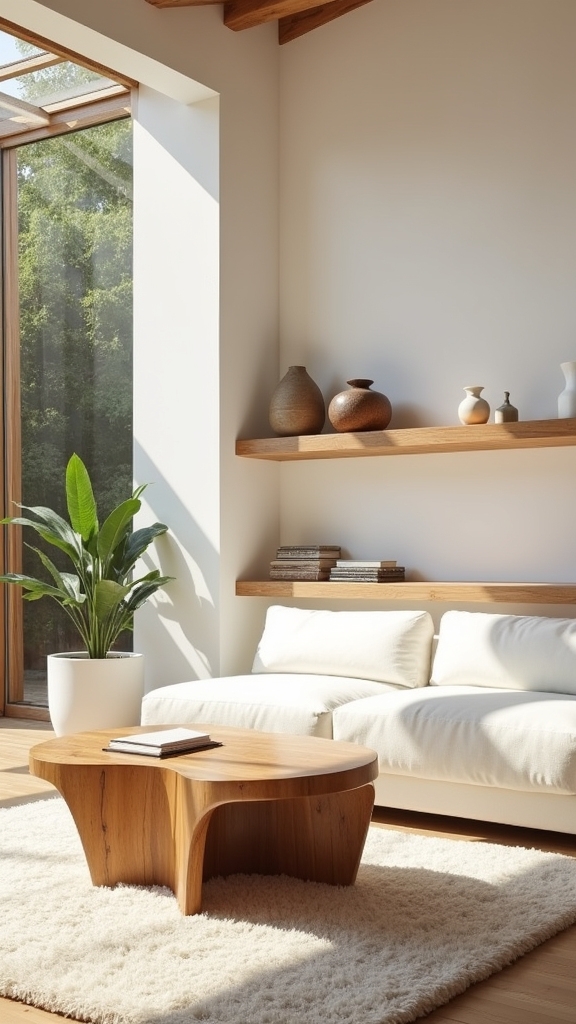
Introducing organic shapes into furniture design enhances the visual harmony of a white and natural wood living room, fostering a seamless flow that mirrors the soft, asymmetrical curves found in nature. Expertly crafted pieces with rounded edges and freeform silhouettes introduce organic elements that disrupt rigid geometry, softening the overall composition. Incorporating soft curves in sofas, coffee tables, and accent chairs not only boosts comfort but also creates a welcoming atmosphere, ideal for relaxation. The use of natural wood, with its distinctive grain patterns and tactile surfaces, further amplifies the connection to the outdoors while adding depth and warmth. Furniture with dynamic, organic forms encourages flexible spatial arrangements, optimizing movement through the space and achieving a balanced, cohesive design rooted in modern, earthy aesthetics. Integrating rattan, wicker, and raw wood can further enhance the organic aesthetic, as these natural elements add texture and an organic feel to the overall design.
Add Greenery for a Fresh, Natural Touch
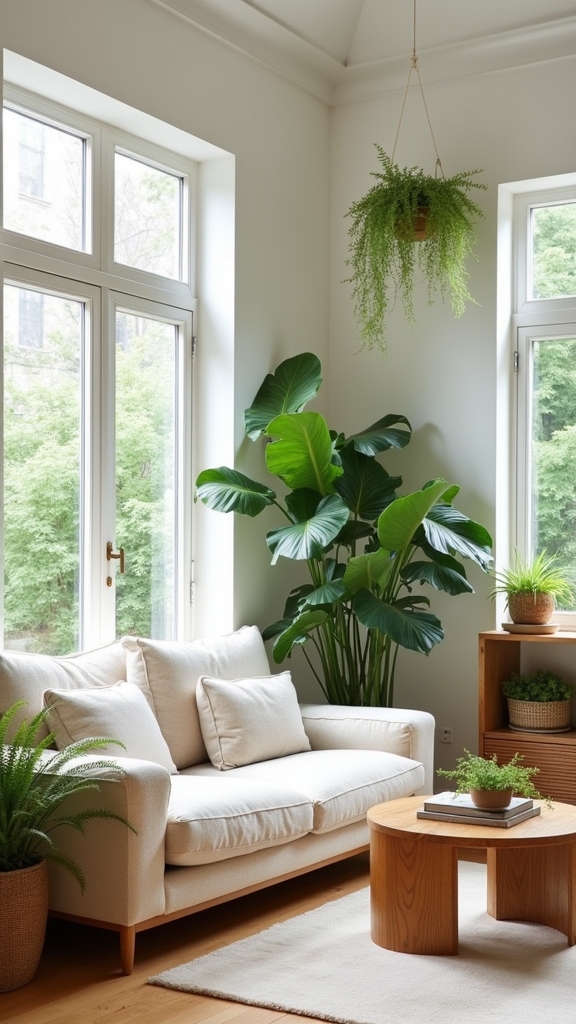
When thoughtfully incorporated, greenery serves as a dynamic counterpoint to the crisp palette of white and natural wood, infusing the living room with vibrant energy and visual depth. To effectively add greenery, designers often curate an indoor garden with a mix of botanical species—such as Monstera and snake plants—to enhance the earthy ambiance. Employing hanging planters or trailing vines leverages vertical space, introducing natural elements that bridge the interior with the outdoors and enrich spatial interest. Varying plant sizes and foliage textures disrupt rigid lines, lending a softer, more welcoming aesthetic. For cohesion, plants can be grouped in terracotta pots or woven baskets, ensuring materiality aligns seamlessly with wood accents. This strategic integration improves air quality while fostering tranquility and a visually harmonious environment. Additionally, incorporating air-purifying plants can enhance the room’s air quality and contribute to a healthier indoor environment.
Use Light Wood Flooring for an Airy Feel
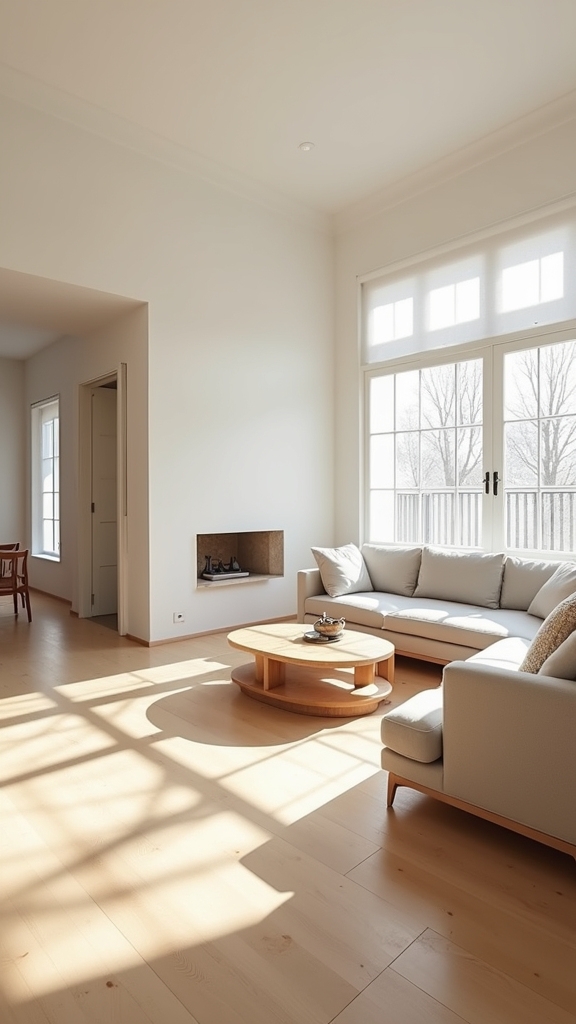
Building on the organic warmth introduced by greenery, light wood flooring further enhances the living room’s sense of spaciousness and clarity. Light wood, such as oak or maple, acts as a reflective surface, amplifying natural light and creating an airy feel that visually enlarges any space. Its subtle grain and pale hue integrate seamlessly with white palettes, achieving a harmonious, modern look. Sustainability-minded homeowners can select eco-friendly, responsibly sourced light wood, underscoring both environmental priorities and a grounded, earthy vibe. Integrating natural elements like houseplants and wooden accents can further enrich the ambiance, adding texture and warmth to the living room. The following table illustrates key design impacts and considerations:
| Feature | Visual Effect |
|---|---|
| Light Wood Tone | Expansive, bright, cohesive |
| Reflects Natural Light | Increases perceived openness |
| Complements White Palette | Unified, modern aesthetic |
| Sustainable Sourcing | Eco-conscious, organic appeal |
Style With Minimal, Earthy Accessories
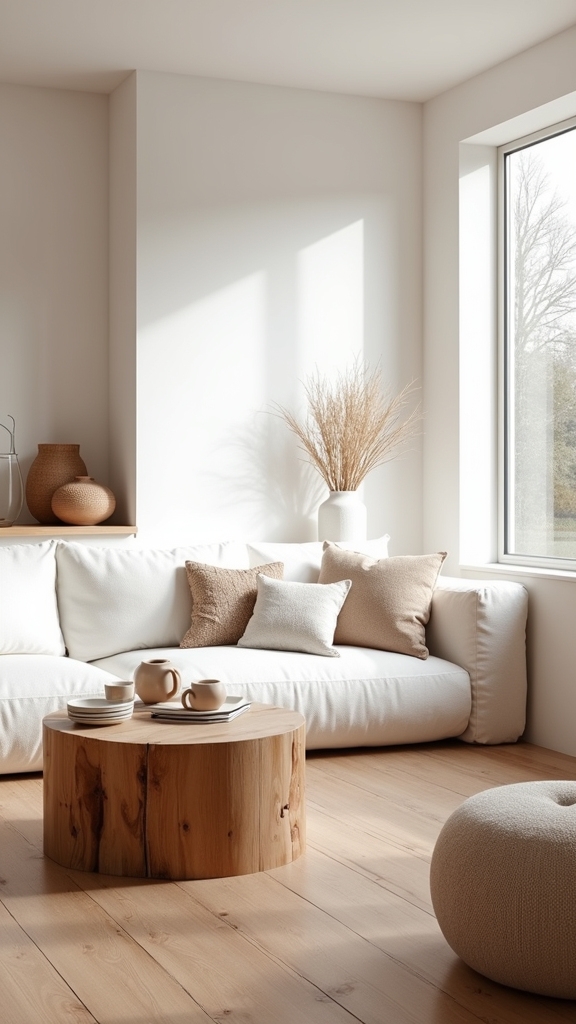
To reinforce a cohesive white and natural wood palette, designers recommend selecting understated organic decor, such as sculptural clay vessels or stone accents, that introduce visual interest while preserving simplicity. Handcrafted textiles in linen or cotton, chosen for their subtle texture and neutral tones, anchor the look and add warmth without visual clutter. This balanced approach enables the living room to feel curated and serene, with each accessory serving a functional and aesthetic purpose. Integrating sustainable living principles by using eco-friendly materials like reclaimed wood not only enhances the room’s aesthetic but also supports ethical sourcing and longevity.
Choose Subtle Organic Decor
Organic decor, defined by its use of natural materials and understated design, anchors the serene aesthetic of a white and natural wood living room.
To achieve this look, designers recommend selecting accessories crafted from elemental substances such as clay, stone, and woven fibers. These pieces introduce both tactile interest and organic authenticity without overwhelming the visual harmony.
Opting for minimalist accessories in muted, earthy tones guarantees cohesion with the foundational white and wood palette, enhancing the calming ambiance. Subtle patterns on vases or wall art can inject visual nuance while preserving clarity and airiness.
Incorporating artisanal or handmade items further raises the space, supporting sustainable choices and adding unique character. Botanical elements or motifs in decor accessories reinforce the connection to nature, completing the earthy, modern look.
Highlight Handcrafted Textiles
A curated selection of handcrafted textiles—such as woven throws and artisanal cushions—introduces nuanced texture and visual interest to a white and natural wood living room.
Opting for textiles in natural colours, particularly neutral or earth-toned palettes, establishes visual harmony and enhances the serene atmosphere.
Layering textures like soft wool, linen, and cotton provides depth, warmth, and tactile complexity, creating an inviting yet grounded environment.
Integrating minimal, earthy accessories—clay pots, wooden bowls, or stone coasters—further amplifies the organic aesthetic, offering balanced contrast to the clean lines and light tones of the space.
Choosing locally sourced or ethically crafted textiles not only supports artisans but also strengthens the modern, earthy character of the living room, delivering both style and sustainability in equal measure.
Choose a White Sofa for a Clean Foundation
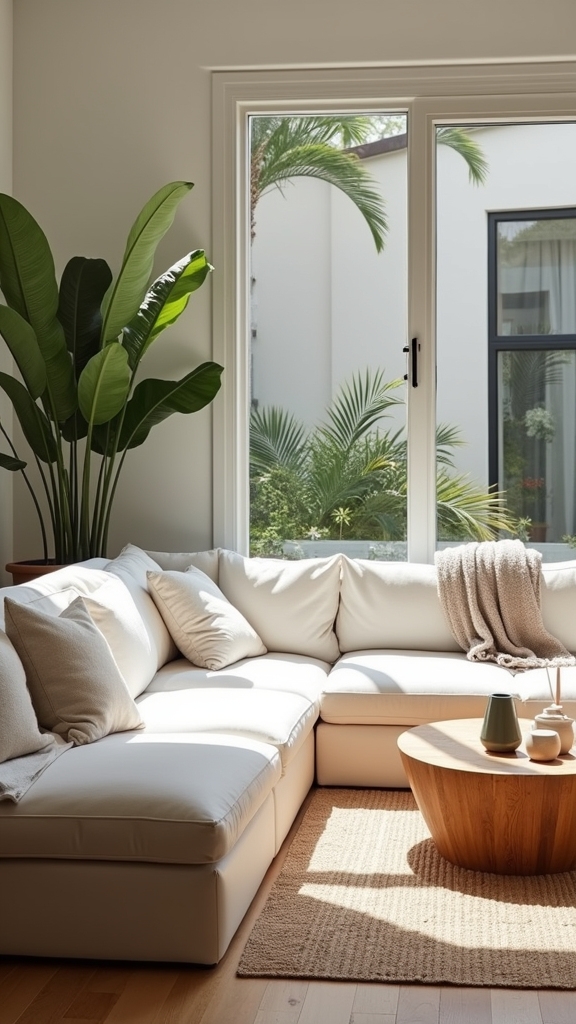
Many designers recognize that selecting a white sofa establishes a crisp, adaptable foundation that seamlessly integrates with both earthy and modern living room aesthetics.
The inherent versatility of a white sofa allows for effortless layering with colorful or textured accessories, supporting dynamic visual interest without overwhelming the space.
White upholstery is particularly effective at reflecting the light, amplifying brightness, and enhancing the perception of spaciousness—an essential strategy in compact living areas.
When paired with natural wood accents such as coffee tables or shelving, the white sofa fosters a harmonious balance between contemporary minimalism and the organic warmth of wood.
Practical considerations also favor white sofas, as removable or washable covers guarantee ongoing freshness and easy maintenance, preserving the inviting and pristine appeal central to modern, earth-inspired interiors.
A white sofa can also be paired with sumptuous textures like velvet or silk to elevate the tactile experience and add a layer of luxury to the living room.
Contrast With Darker Wood Elements
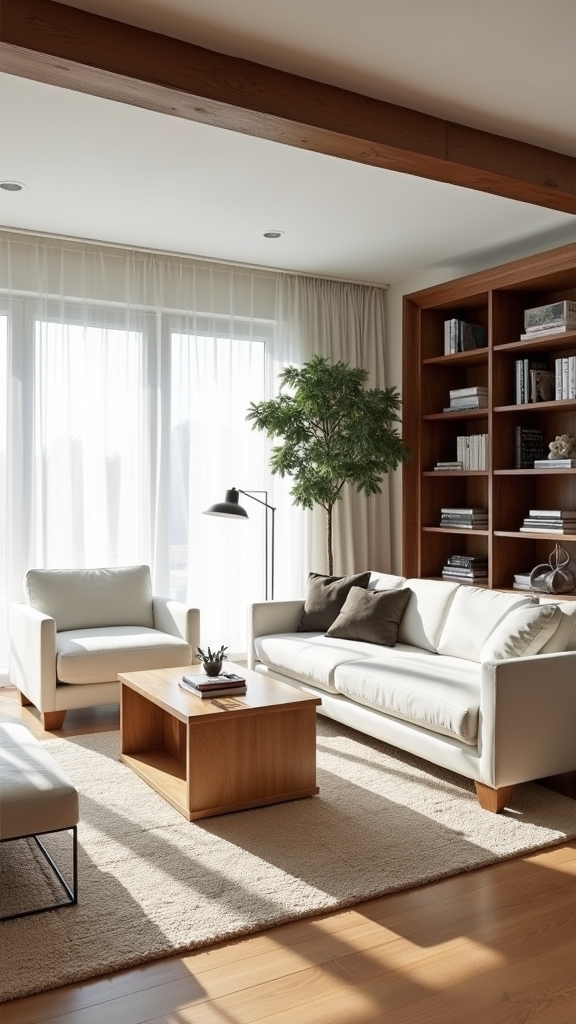
Introducing darker wood elements strategically balances the interplay of light and shadow, lending visual interest and depth to primarily white and natural wood interiors.
These richer tones can be used to accentuate architectural features such as ceiling beams or built-in shelving, drawing attention to the room’s structural character.
This approach guarantees a measured contrast that both anchors the space and highlights its most distinctive details.
Incorporating layered illumination techniques can further enhance the warmth and functionality of the living room, adding depth and dimension to the overall design.
Balancing Light and Dark
While white walls establish a crisp and airy backdrop in the living room, integrating darker wood elements such as mahogany or walnut furniture introduces a purposeful contrast that enhances spatial depth and visual intrigue.
This interplay of light surfaces and dark wood accents is essential for achieving a balanced, contemporary aesthetic without sacrificing warmth and comfort. Expertly placed darker wood features act as grounding anchors, ensuring the space feels cohesive rather than stark.
Consider the following strategies:
- Strategic Placement: Position dark wood coffee tables or shelving units against light backgrounds to maximize visual impact.
- Material Pairing: Combine dark wood accents with soft, light textiles (such as linen throws or ivory cushions) for both tactile and visual harmony.
- Zoning: Use varying wood tones to subtly delineate different functional zones within open-plan living spaces.
Highlighting Architectural Features
Though white walls and natural wood create an expansive and serene backdrop, the integration of darker wood elements serves to emphasize architectural features such as beams, window trims, and built-in shelving.
By strategically highlighting these components with deeper wood tones—like walnut or mahogany—designers introduce a compelling visual hierarchy that adds depth and dimension to the living space.
This contrast not only delineates zones within open-plan layouts but also creates focal points that subtly command attention.
Utilizing darker wood for key features or select furnishings enhances the room’s modern, earthy appeal without compromising warmth.
To create a cohesive design, balancing these accents with tactile textiles and organic décor guarantees the space remains inviting while underscoring the architectural framework with purposeful sophistication.
Display Handmade or Vintage Decor Pieces
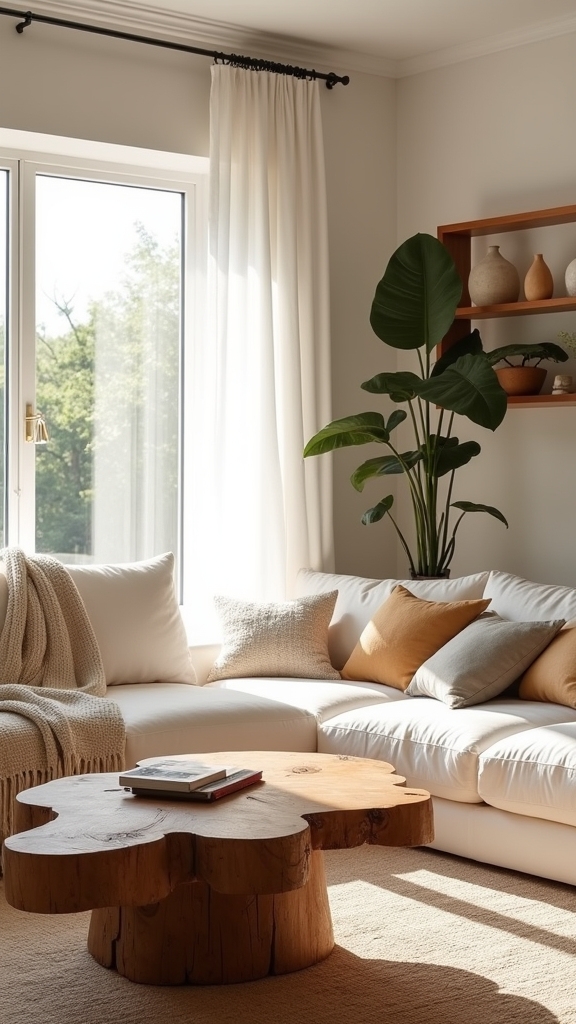
Curating handmade or vintage decor pieces infuses a living room with authentic character and visual interest, elevating the white and natural wood aesthetic.
Expertly selected vintage decor—such as reclaimed wood shelves or artisanal pottery—introduces rich history and sustainability, reducing reliance on mass-produced items.
Handmade accents, featuring natural textures like woven baskets or hand-carved wood, establish tactile depth, harmonizing with the room’s organic palette.
Thoughtfully displaying these elements encourages a layered, story-driven space that feels both curated and personal.
Reclaimed Wood Shelves: Offer both function and sustainable charm, highlighting the beauty of natural textures.
Artisanal Pottery: Brings visual warmth and a unique, handcrafted appeal.
Woven Baskets: Introduce tactile contrast and provide practical storage while reinforcing an earthy, cohesive atmosphere.
Integrating vintage and modern decor showcases unique styles and personal journeys, with each piece serving as a canvas for interests, memories, and aesthetic preferences.
Highlight Natural Light With Sheer Curtains
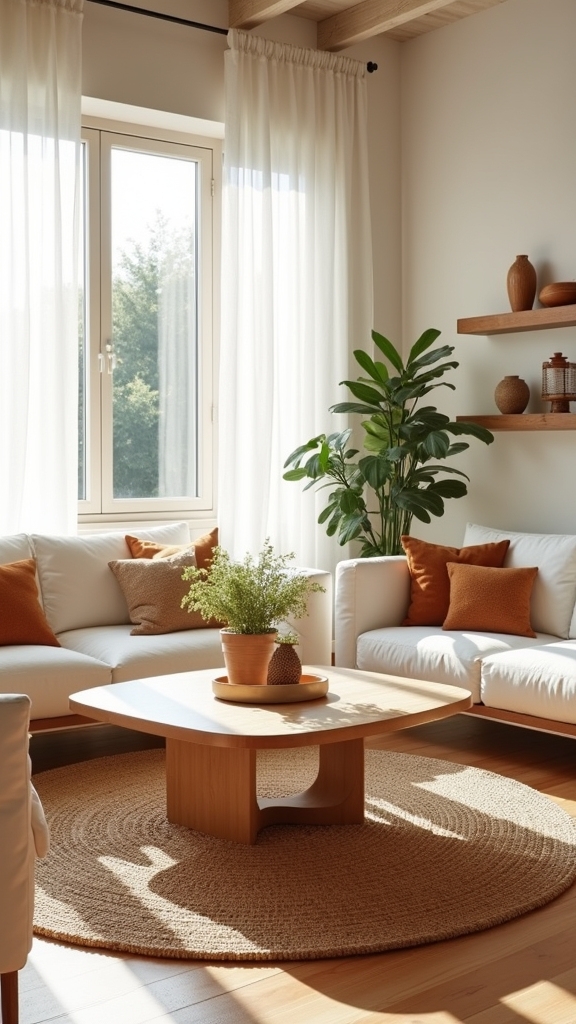
Sheer curtains optimize sunlight exposure by diffusing natural light throughout the living room, elevating both brightness and visual comfort. Their translucent quality fosters an airy ambiance, amplifying the sense of space and complementing the crisp contrast of white walls with natural wood accents. This approach not only enhances spatial perception but also supports a cohesive, modern aesthetic. Additionally, incorporating energy-efficient lighting options such as LED bulbs can further enhance the room’s brightness while aligning with sustainable practices.
Maximizing Sunlight Exposure
How can a living room achieve ideal luminosity while maintaining privacy and design cohesion? The solution lies in maximizing sunlight exposure by utilizing sheer curtains, which transform natural light into a design asset.
Sheer fabrics in white or soft beige seamlessly integrate with natural wood, resulting in a space that feels both warm and expansive. Their translucency softens direct sunlight, minimizing glare and shielding furnishings from UV damage, thereby preserving the longevity of wood finishes.
- Position sheer curtains on windows with the greatest sun exposure to amplify brightness and foster a welcoming atmosphere.
- Select light, neutral-toned sheers to enhance cohesion with wood elements and create a warm, inviting palette.
- Leverage the light-filtering properties to maintain privacy while ensuring the living room remains luminous and visually open.
Enhancing Airy Ambiance
When aiming to cultivate an airy ambiance in a white and natural wood living room, the strategic use of sheer curtains becomes essential for enhancing natural light. Sheer curtains, with their lightweight composition, diffuse sunlight to reduce glare, infusing the space with a gentle, luminous glow. This approach not only maintains privacy but also enhances the sense of openness and spaciousness, significant for an earthy, modern aesthetic. Using light-colored sheers further amplifies brightness and visually expands the area. For ideal versatility, layering sheer curtains with heavier drapes permits precise light control while preserving the desired airy ambiance throughout the day. The table below summarizes the key benefits and applications:
| Feature | Solution/Benefit |
|---|---|
| Sheer Fabric | Softens light, reduces glare |
| Light Color | Enhances spacious, bright feeling |
| Layering Options | Versatile light and privacy control |
Mix Woven Baskets and Rattan Accents
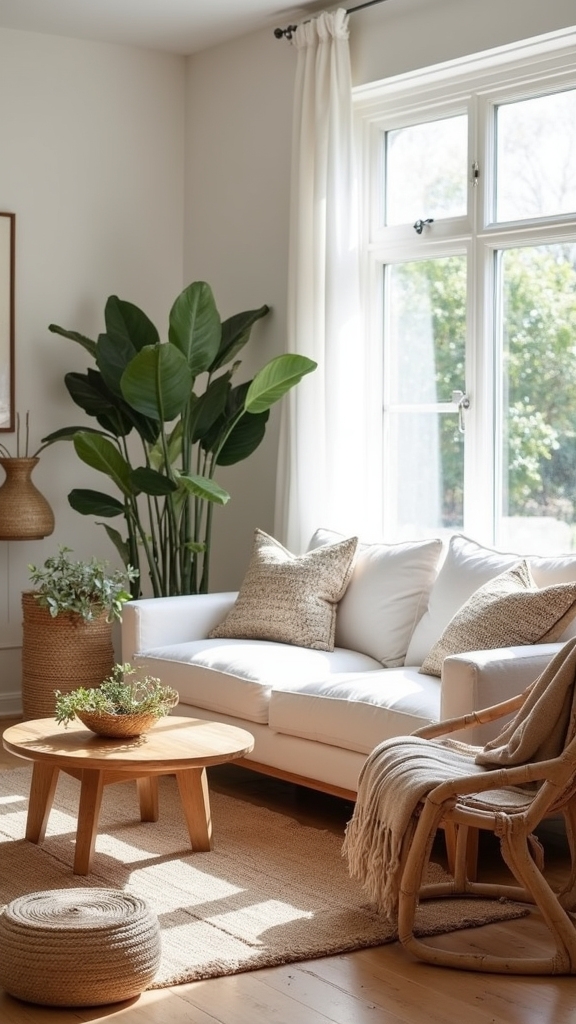
Within a white and natural wood living room, the integration of woven baskets and rattan accents introduces essential texture and warmth, enhancing the space’s organic character while retaining a contemporary edge.
Experts recommend utilizing these elements to cultivate natural elegance and visual depth. Woven baskets serve dual purposes as both functional storage and decorative statements, while rattan accents—whether in seating, shelving, or lighting—reinforce a sense of airiness and sustainability.
To maximize impact and sophistication:
- Arrange woven baskets of varying sizes and shapes to establish layered interest and organized storage.
- Select rattan accent pieces, such as lounge chairs or pendant lights, to infuse tactile appeal and natural elegance.
- Emphasize eco-friendly materials to align with sustainable design principles, reinforcing an earthy, modern aesthetic.
Feature a Statement Coffee Table in Natural Material
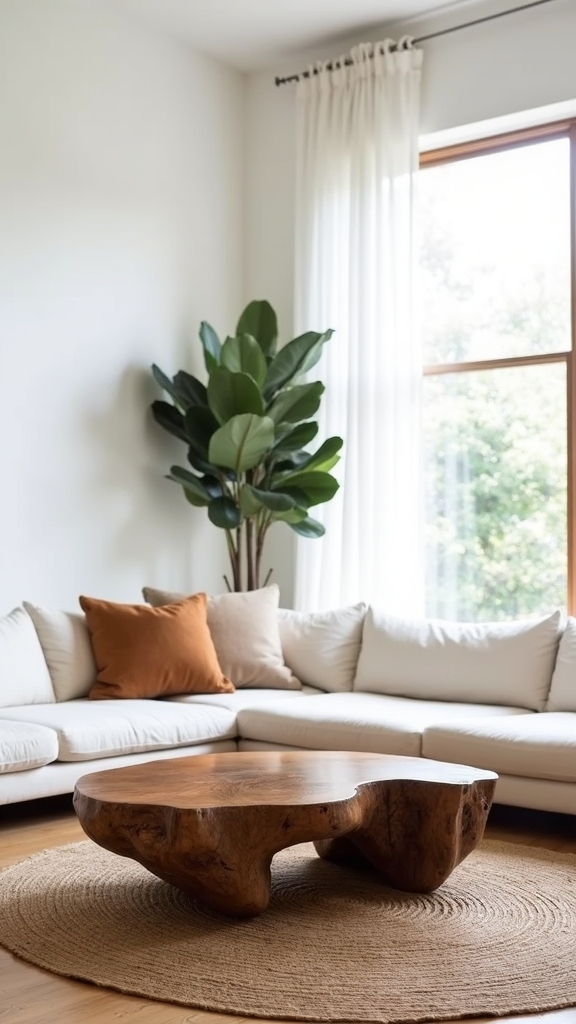
A single statement coffee table crafted from natural materials—such as reclaimed wood or live edge slabs—anchors a white and natural wood living room by introducing organic warmth and distinctive character.
Selecting a table with pronounced grain patterns or tactile textures establishes a striking visual contrast against minimalist white surroundings, reinforcing an earthy feel.
Raw or unfinished surfaces not only maintain the authenticity of natural materials but also emphasize sustainable design, especially when reclaimed wood is incorporated.
For modern practicality, coffee tables with integrated storage or nesting features preserve a clutter-free environment while retaining rustic charm.
Complementing the statement coffee table with tactile textiles and greenery further softens the space, ensuring cohesion and comfort.
This approach highlights natural wood’s inherent beauty and grounds the room’s overall aesthetic.
Integrate Stone or Ceramic Decor
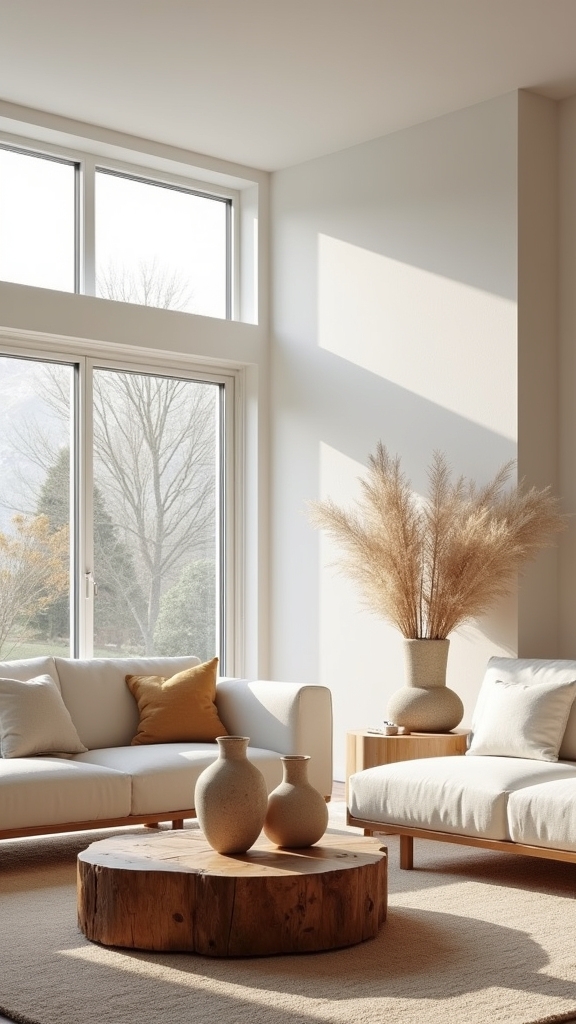
Although the foundation of a white and natural wood living room is inherently serene, introducing stone or ceramic decor elements strategically enhances the tactile and visual complexity of the space.
Stone and ceramic decor elevate a serene white and wood living room with added texture and visual depth.
The use of natural materials such as stone accents and ceramic decor brings an authentic, grounded character while reinforcing the modern earthy aesthetic. Thoughtfully integrating these materials not only raises the sensory experience but also promotes a sense of sustainability and sophistication.
- Stone Accents: Consider a travertine coffee table or slate coasters to impart a refined, grounding presence.
- Textured Ceramic Decor: Opt for handcrafted ceramic bowls or planters, offering subtle color and finish variations for visual intrigue.
- Mixed-Material Harmony: Layer stone and ceramic items with wood and textiles to achieve a balanced, inviting ambiance.
Create Visual Interest With Wood Wall Paneling
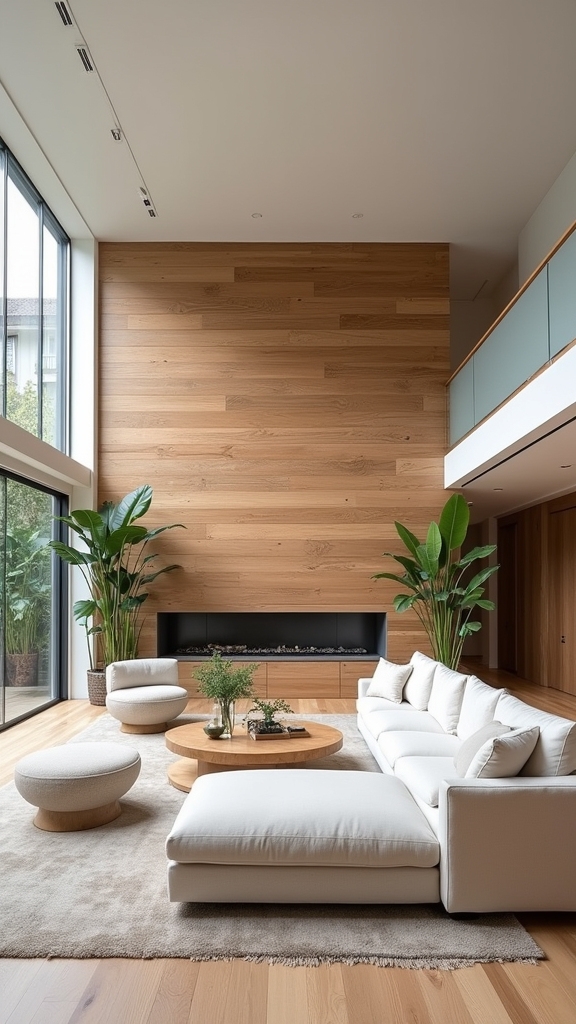
Many contemporary living rooms benefit from the introduction of wood wall paneling, which enhances both tactile richness and visual depth in a primarily white and natural wood scheme.
Employing wood wall paneling introduces visual interest through dynamic patterns—horizontal or vertical slats create rhythm and perspective, amplifying architectural impact.
Reclaimed wood paneling brings unique character and supports sustainability, while lighter species such as pine or birch brighten the environment, preserving an airy, modern aesthetic.
These material choices reinforce an earthy feel, grounding the space while complementing minimalist decor.
Additionally, wood wall paneling contributes to improved acoustics, fostering a warm, inviting atmosphere ideal for relaxation or conversation.
Strategic paneling consequently offers a solution-oriented approach to crafting visually compelling and sensorially rich living rooms.
Frequently Asked Questions
What Color Wood Goes Best With White?
When evaluating ideal wood color combinations with white, experts recommend warm wood tones like oak or maple for a balanced effect. White wood accents paired with these hues enhance visual harmony, offering both modern clarity and organic warmth.
How Do I Make My Living Room Look Modern?
To achieve a modern living room, one should prioritize minimalist decor, select contemporary furnishings with clean lines, and maintain open spaces. Visual harmony is enhanced by uncluttered layouts, functional pieces, and a restrained color palette, ensuring a sophisticated atmosphere.
Is Natural Wood Furniture in Style?
Natural wood trends remain prominent in modern furniture, driven by sustainable design priorities and a visual emphasis on organic textures. Designers recommend incorporating artisanal wood pieces to achieve a contemporary aesthetic while promoting eco-conscious living and enduring interior appeal.
How Do You Make an Earthy Living Room?
To create an earthy living room, designers recommend integrating natural textures like wood and stone, utilizing earthy palettes with browns and muted greens, and layering cozy accents—such as woven rugs and textiles—to enhance visual warmth and tactile comfort.
Conclusion
By thoughtfully combining crisp white elements with natural wood, these living room ideas strike a harmonious balance between modern minimalism and organic warmth. Integrating tactile textures, organic shapes, and natural materials—such as rattan, stone, and ceramics—introduces visual depth and comfort. Strategic use of greenery and light wood flooring enhances the earthy ambiance. Ultimately, these solutions create living spaces that are both visually cohesive and inviting, exemplifying the enduring synergy between contemporary design and nature-inspired aesthetics.
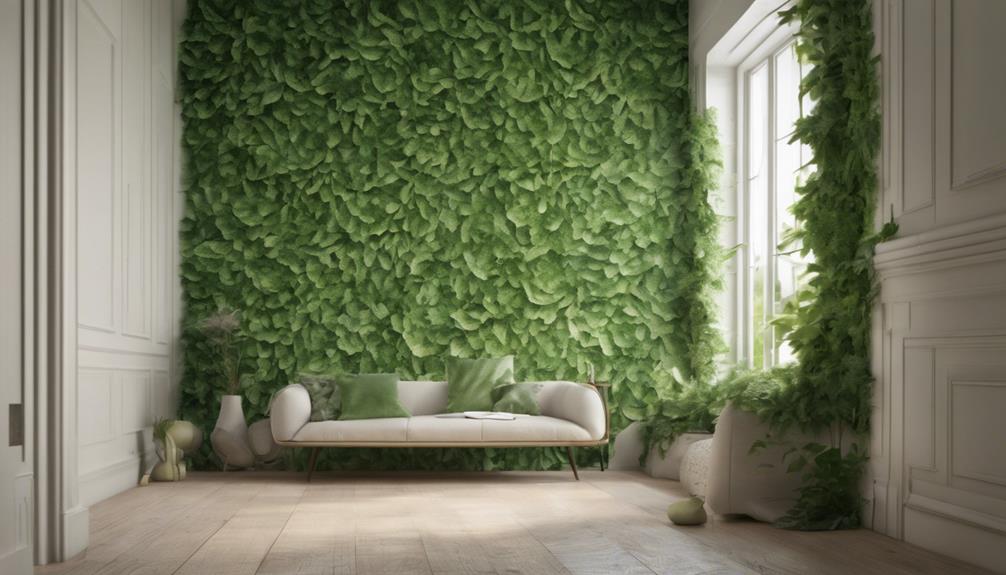
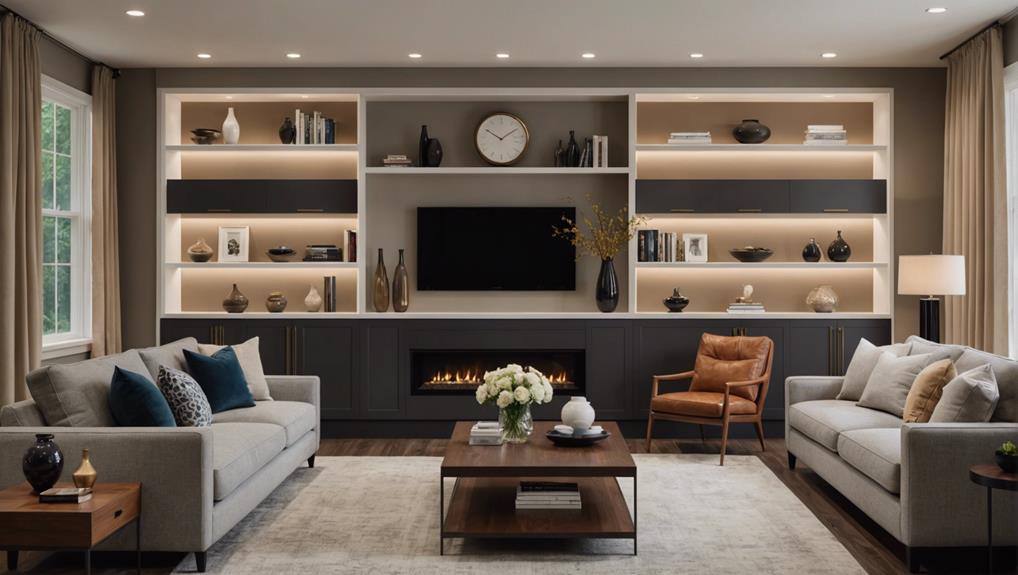
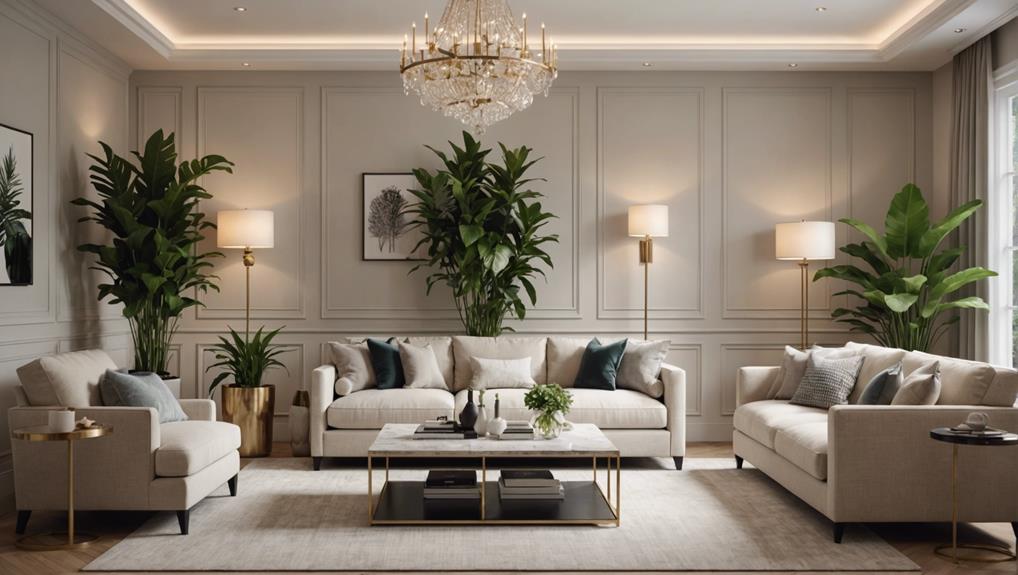
Leave a Reply